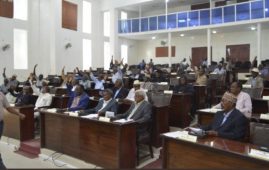One of the main foci of the Growth and Transformation Plan is development of sugar production. The government intends that Ethiopia should be self-sufficient in sugar by the end of 2013 and increase production almost eightfold to 2.3 million tonnes by mid-2015, leaving a surplus for export of 1.25 million tonnes, making the country one of the world’s ten biggest exporters. The choice of sugar for development is based on the potential in terms of climate and in soil and water resources. The expected cost of the development of the planned ten factories and associated plantations is about 80 billion birr ($4.6 billion).
Included in this are efforts to finalize the expansion of the three existing sugar factories within the shortest possible time. The existing facilities, at Wonji, Metehara and Fincha, currently produce 75,000, 136,692 and 110 tonnes of sugar respectively, though their total capacity should be nearer 300,000 tonnes. To resolve current shortages for the domestic market, the country is currently having to import 180,000 – 200,000 tonnes a year. Domestic demand is running at around 450,000 tonnes.
The major emphasis of the proposed developments, however, is in the ten projects now being built. The new projects are located at Tana Beles in the Amhara Regional State; Welkayt in Tigrai Regional State, Kesem and Tendaho in Afar Regional State and the Kuraz project for six factories in the South Omo Zone of the Southern Nations Nationalities and Peoples’ Regional State. The factory and plantation development, of course includes construction of dams and roads, irrigation and infrastructural development both in the immediate vicinity of the projects and around them. Studies of the design elements for the factories, irrigation, road construction and other elements have been carried out.
The projects are of differing size and capacity. Tendaho will include a total area of 50,000 hectares of sugarcane plantation, and will be the largest sugar mill in the country able to produce 619, 000 tonnes of sugar a year as well as 55,405 cubic meters (m3) of ethanol and 94 MW of electricity a year for the national grid. It is expected to start sugar production later this year and ethanol next year. It will be providing a total of 42,000 jobs for the local community.
Welkayt will have one factory able to crush 24,000 tonnes of sugar cane a day. Once full production is reached it is expected to produce 284,000 tones of sugar and 26,750 m3 of ethanol a year. Following the expression of concern that the development might affect a monastery in the area the government carried out a series of consultations with all stakeholders, including local farmers and others around as well as technical experts. There was a total consensus that the construction of the dam for the plantation would cause no problems for the monastery, but rather would make a significant contribution to the facilities and development of the whole locality including the monastery.
Of the other projects, Beles will have three factories with crushing capacity of 12,000 tonnes of sugar cane each per day. Kesem is going to be developed in two stages with stage one crushing up to 6,000 tonnes of sugar cane per day and phase two having a 12,000 tonne capacity. The South Omo development at Kuraz will have three factories, each with a crushing capacity of 12,000 tonnes a day. There will be three other factories of similar capacity in the South Omo zone. At full production, these will all be able to produce 278,000 tonnes of sugar and 26,162 m3 ethanol a year. The project currently allows for 20,652 residential houses to be built as well as access and feeder roads to link plantations, factories and villages as well as link with the rest of the regional state. A start has been made on all these developments as well as on the required irrigation infrastructure, necessary dams and other support activity.
These projects will certainly bring significant changes for the residents of the region, socially, economically and culturally, and all with their own full consent. Those directly affected by the developments are being compensated for lost earnings and given land at least equal to their previous holdings. The implementation of the projects is also allowing for local access to a wide variety of additional developments: access to schools, health centers, to water and electricity, and telephone links as well as roads and other links. The Director-General of the Sugar Corporation, Abay Tsehaye, has emphasized that previously impoverished communities will become far better off as they benefit from irrigated land, improved social services, support from agricultural experts and job opportunities. In total it is estimated that the projects will provide directly more than 200,000 jobs for local people, and associated development activities will provide for doubling that figure to 400,000. Ato Abay said “Groups campaigning against the plans have selfish motives. They want these people to remain as primitive as they used to be, as poor as they used to be, as naked as they used to be, so that they can continue to provide specimens for research and an agenda for raising funds”.
The Sugar Corporation has carried out extensive activities in the last two years to get these projects under way. These have included evaluations of possible problems with all concerned bodies and all possible stakeholders, and making every effort to identify challenges in advance and create a friendly environment for the developments. Its efforts have also included substantial training for the Corporation’s management staff, for project coordinators and for the employees of the new factories and all support staff.
****************
* Originally published on A Week in the Horn – February 22, 2013 issue, titled “Ethiopia’s sugar development progressing steadily”. Items from A Week in the Horn are re-published here with a permission to do so. You may republish it with attribution and no modification to its contents.
Check the archive for related posts.





